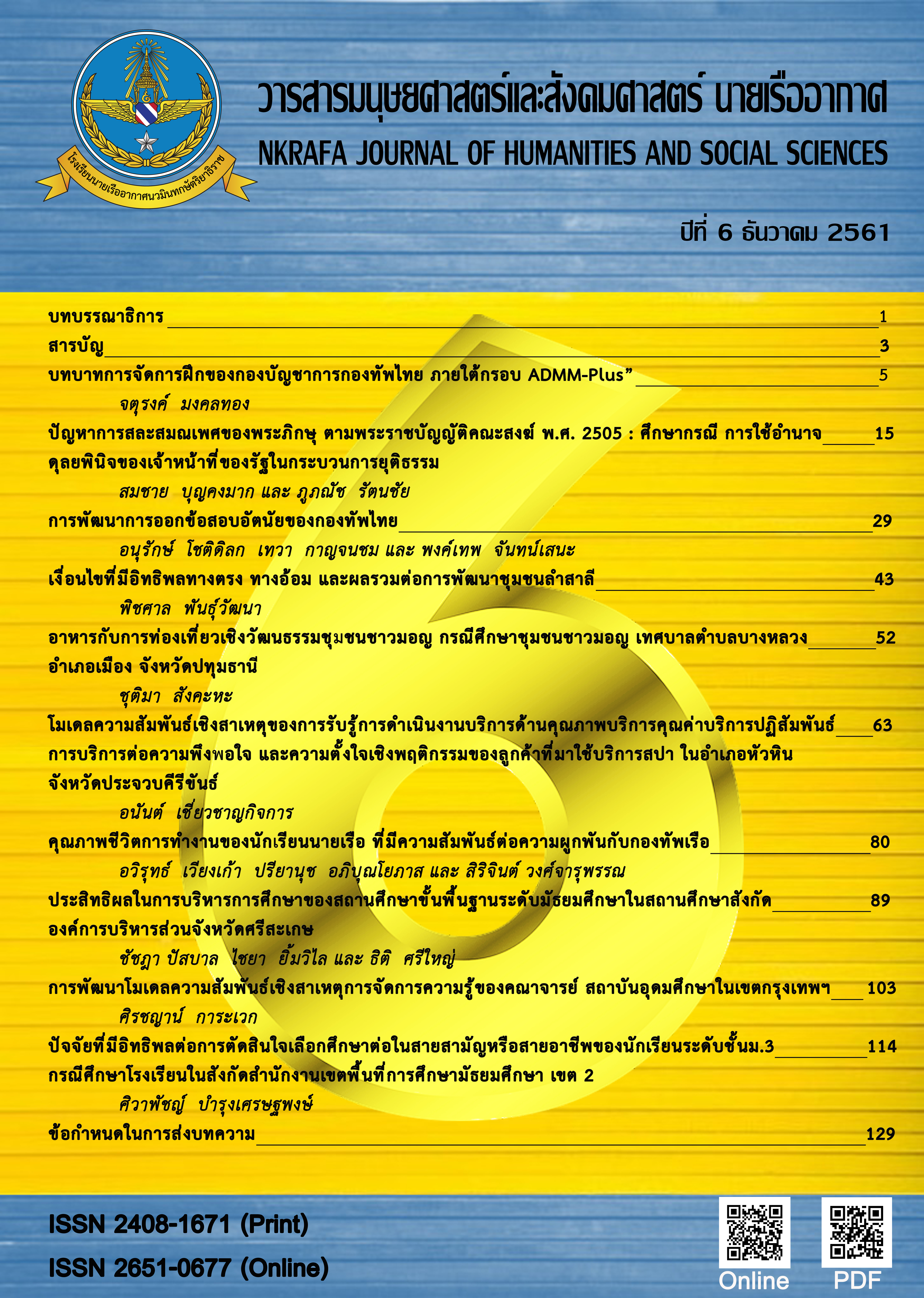The Condition of Direct Indirect and Total Influence to Lam-Sali’s Community Development
Main Article Content
Abstract
Abstract
The purposes of this research were to study 1) generality of person in lam-sali community and 2) The influence of the economic fundamentals, change leader, politics and person in community. This study was conducted by applying two research methodologies. Quantitative approach, questionnaire was used to collect data from 129 person. The data was analyzed, using path analysis and descriptive statistics. To the qualitative approach, in-depth interview, observation and field notes were conducted with 14 persons. The results indicated that person in community had the most direct influence to community development and the economic fundamentals had the most indirect and total influence to community development of lam-sali community.
Article Details
บทความที่ได้รับการตีพิมพ์เป็นลิขสิทธิ์ของวารสารมนุษยศาสตร์และสังคมศาสตร์ นายเรืออากาศ
ข้อความที่ปรากฎในบทความแต่ละเรื่องในวารสารวิชาการเล่มนี้ เป็นความคิดเห็นส่วนตัวของผู้เขียนแต่ละท่าน ไม่เกี่ยวข้องกับโรงเรียนนายเรืออากาศฯ และคณาจารย์ท่านอื่น ๆในโรงเรียนนายเรืออากาศฯ แต่อย่างใด ความรับผิดชอบขององค์ประกอบทั้งหมดของบทความแต่ละเรื่องเป็นของผู้เขียนแต่ละท่าน หากมีความผิดพลาดใด ๆ ผู้เขียนแต่ละท่านจะรับผิดชอบบทความของตนเองแต่เพียงผู้เดียว
References
[2] สุชาติ ประสิทธิ์รัฐสินธุ์. (2555). ระเบียบวิธีวิจัยทางสังคมศาสตร์. กรุงเทพมหา นคร: สามลดา
[3] สุชาติ ประสิทธิ์รัฐสินธุ์. (2554). วิธีวิทยาการวิจัยเชิงคุณภาพยุคใหม่. กรุงเทพ มหานคร: สามลดา.
[4] สำนักงานเขตบางกะปิ. (2561). ชุมชน. สืบค้นเมื่อ 24 มีนาคม 2561 จาก http://w ww.bangkok.go.th/bangkapi/page/sub/1205/ชุมชน
[5] Agarwal, J., Osiyevskyy, O., & Feldman, P.M. (2015). Corporate reputation measurement: Alternative factor structures, nomological validity and organizational outcomes. Journal of business ethics, 130(2), 485-506.
[6] Dasgupta, A., & Beard, V.A. (2007). Community driven development, collective action and elite capture in Indonesia. Development and Change, 38(2), 229–249.
[7] Elliott, S.D. (2013). The historical, political, social, and individual factors that have influenced the development of aging and disability resource centers and options counseling. A thesis for the degree of master of urban studies. Portland State University.
[8] Fusch, P.I., & Ness, L.R. (September 2015). Are we there yet? Data saturation in qualitative research. The Qualitative Report, 20(9), 1408-1416.
[9] Hecimovich, M.D., & Hebert, J.J. (2016). Reliability and concurrent validity of an alternative method of lateral lumbar range of motion in athletes. SAJSM, 28, 23-26.
[10] Palinkas, L. A., Horwitz, S. M., Green, C. A., Wisdom, J. P., Duan, N. & Hoagwood, K. (2015). Purposeful sampling for qualitative data collection and analysis in mixed method implementation research. Adm Policy Ment Health, 42(5), 533–544.
[11] Peeters, M.J., Beltyukova, S.A., & Martin, B.A. (2013). Educational testing and validity of conclusions in the scholarship. Am J Pharm Educ, 77(9), 186.
[12] Resch, J., Driscoll, A., McCaffrey, N., Brown, C., Ferrara, M.S., & Macciocchi, S. (2013). Impact test-retest reliability: Reliably unreliable?. Journal of Athletic Training, 48(4), 506-511.
[13] Rogers, K.D., Pilling, M., Davies, L., Belk, R., Green, C.N. & Young, A. (2016). Translation, validity and reliability of the British sign language (BSL) Qual Life Res, 25, 1825-1834.
[14] Rojas, S.L., & Widiger, T.A. (2013). Convergent and discriminant validity of the five factor form. Assessment, 21, 143-157.
[15] Ryu, E. (2013). Factorial invariance in multilevel confirmatory factor analysis. British Journal of Mathematical & Statistical Psychology, 67(1), 172-194.


